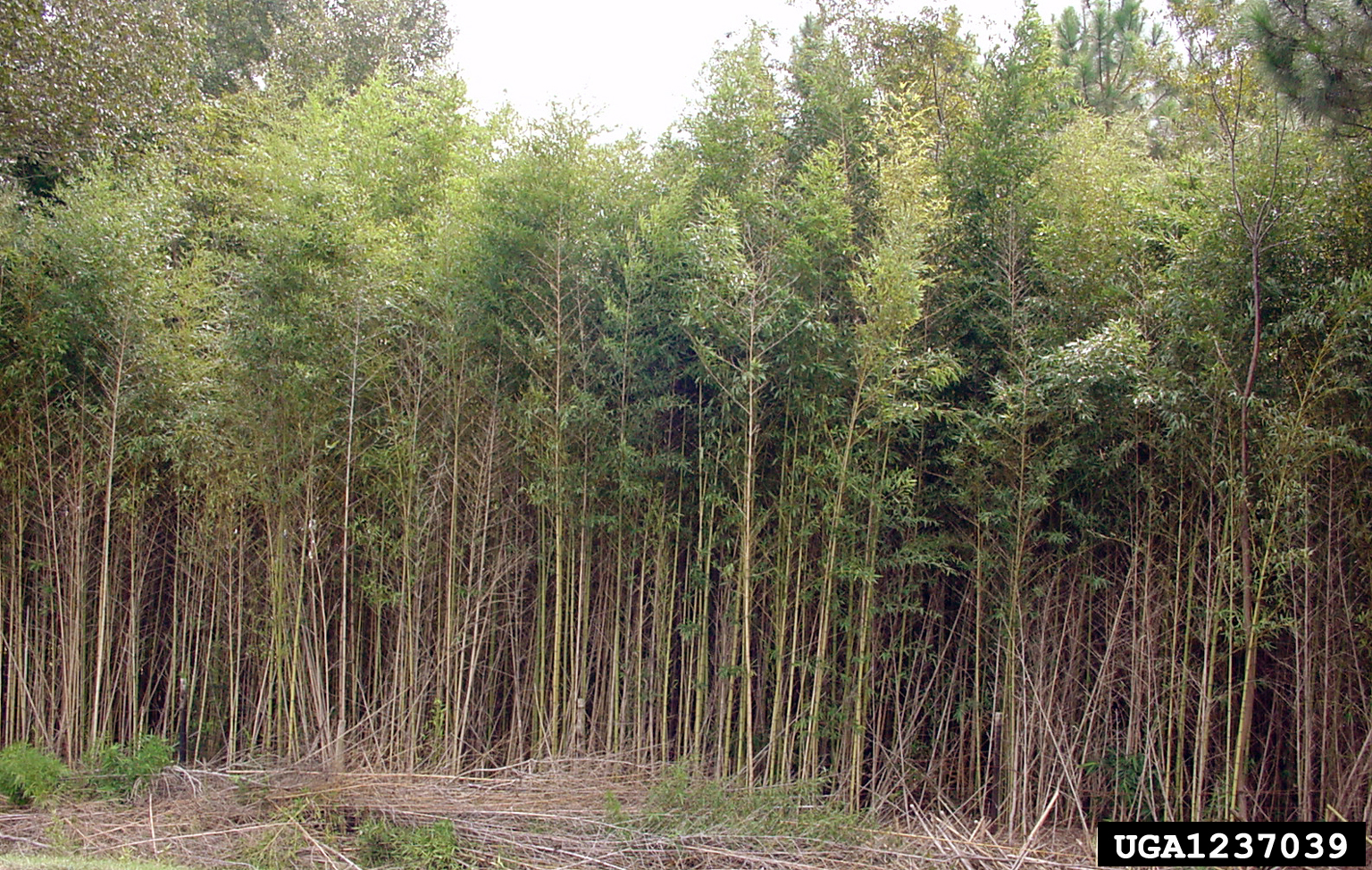Phyllostachys aurea
Golden Bamboo
Synonym(s): Bamusa aurea, Phyllostachys bambusoides var. aurea, Phyllostachys meyeri var. aurea
Family: Poaceae
Duration and Habit: Perennial reed plant

Photographer: Chuck Bargeron, University of Georgia
Source: bugwood.org
Description
Golden bamboo (Phyllostachys aurea) is a perennial reed plant from the family Poaceae, which also includes grasses. Capable of growing tall thick monocultures, the average golden bamboo plant is 16-40 ft (5-12 meters). Flowering is extremely rare occurring every 7 to 12 years. Leaves alternate on the reed and are 3-10 inches long by 0.25-0.75 inches wide. The stems of golden bamboo, also called canes, are consistent with expected bamboo with hollow canes, solid joints, and are 1-6 inches in diameter.
Ecological Threat: Golden bamboo, like many invasive plants, becomes established rapidly and forms thick monocultures preventing native plants from growing in the same area. Wildlife that utilizes plant habitats prevented by golden bamboo are also at risk because of habitat reduction. Once it has become established, golden bamboo is difficult to eradicate from an area because of rapid reproduction and regeneration when damaged.
Biology & Spread: Golden bamboo is not a regular flowering plant and can be observed to flower once every 10 years on average. Reproduction of golden bamboo occurs via rhizomes that are spread away from the parent plant. New shoots appear from the sides of the rhizomes on alternate nodes.
History: Golden bamboo was introduced to the United States as an import for ornamental purposes in 1882. It was favored for its height, which serves as a privacy, sound, and light barrier in gardens. Golden bamboo is difficult to contain in confined areas due to aggressive reproduction via rhizomes.
U.S. Habitat: With a preference for full sun and warm climates, golden bamboo is also capable of growing in environmentally unfavorable conditions. Outside of planned growth in garden landscapes, golden bamboo can be found in wooded forests or surrounding houses and areas where it was intended to grow.
Distribution
Native Origin: China
U.S. Present: AL, AR, CT, DE, FL, GA, HI, KY, LA, MD, MS, NC, OR, SC, TN, TX, VA, WV
For a distribution map provided by EDDmapS click here.
Management
The most effective management method of golden bamboo is prevention. Avoid planting golden bamboo when possible and take extreme care to prevent seed dispersal when removing the plant from unwanted areas. Due to its ability to escape natural areas it is important to reduce growth and distribution of golden bamboo. If there is a small infestation, golden bamboo can be removed by cutting it down to the ground with repeated treatments throughout the year and careful observation for growth in new areas. Herbicide can be used in areas of large infestation with little to no non-target plants in the treatment area. Foliar spay is the best herbicidal method to be applied after cutting back golden bamboo. Herbicide should be applied to new leaves when temperatures are above 65o F to ensure proper absorption. Glyphosate can be used in a 5% dilution with water or imazapyr can be used in a 1% solution. However, imazapyr should not be used as an herbicide if desirable trees are nearby because it is a non specific herbicide.
Text References
Clark, L.G. 1995. Diversity and distribution of the Andean woody bamboos (Poaceae: Bambuseae). In Churchill, S.P.; Baslev, H.; Forero, E.; Luteyn, J., ed., Biodiversity and Conservation of Neotropical Montane Forests. New York Botanical Garden, Bronx, New York, USA. pp. 501-512.
Judziewicz, E.J.; Clark, L.G.; Londoño, X.; Stern, M.J. 1999. American bamboos. Smithsonian Institution Press, Washington, D.C., USA.
USDA Forest Service Golden Bamboo Fact Sheet - Weed of the Week
Internet Sources
http://plants.ifas.ufl.edu/node/324
http://www.na.fs.fed.us/fhp/invasive_plants/
 Texas Invasive Species Institute
Texas Invasive Species Institute